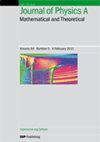纳米通道中聚合物结定位的首次证明
IF 2.1
3区 物理与天体物理
Q2 PHYSICS, MATHEMATICAL
Journal of Physics A: Mathematical and Theoretical
Pub Date : 2024-08-30
DOI:10.1088/1751-8121/ad6c01
引用次数: 0
摘要
基于聚合物缩放理论和数值证据,Orlandini、Tesi、Janse van Rensburg 和 Whittington 于 1996 年猜想,结型 K 网格多边形的极限熵与无结多边形的极限熵相同,K 的结分解中每增加一个质结,熵临界指数就增加一个。这一 "结熵(KE)"猜想与以下观点一致:对于非封闭聚合物,结是以局部方式出现的(与聚合物长度相比,结的部分相对较小)。对于完全封闭(球形或箱形),数值证据表明,结的局部性要小得多。对于纳米通道或管状约束,数值证据则喜忧参半,这取决于如何测量结的大小。在此,我们概述了 KE 猜想在 ∞×2×1 网格管中的多边形中成立的证明,并表明当使用结大小的连接和测量时,结是局部的。类似的结果也适用于连接多边形。这是第一个证明结熵猜想的模型。本文章由计算机程序翻译,如有差异,请以英文原文为准。
A first proof of knot localization for polymers in a nanochannel
Based on polymer scaling theory and numerical evidence, Orlandini, Tesi, Janse van Rensburg and Whittington conjectured in 1996 that the limiting entropy of knot-type K lattice polygons is the same as that for unknot polygons, and that the entropic critical exponent increases by one for each prime knot in the knot decomposition of K . This Knot Entropy (KE) conjecture is consistent with the idea that for unconfined polymers, knots occur in a localized way (the knotted part is relatively small compared to polymer length). For full confinement (to a sphere or box), numerical evidence suggests that knots are much less localized. Numerical evidence for nanochannel or tube confinement is mixed, depending on how the size of a knot is measured. Here we outline the proof that the KE conjecture holds for polygons in the
∞ × 2 × 1 lattice tube and show that knotting is localized when a connected-sum measure of knot size is used. Similar results are established for linked polygons. This is the first model for which the knot entropy conjecture has been proved.
求助全文
通过发布文献求助,成功后即可免费获取论文全文。
去求助
来源期刊
CiteScore
4.10
自引率
14.30%
发文量
542
审稿时长
1.9 months
期刊介绍:
Publishing 50 issues a year, Journal of Physics A: Mathematical and Theoretical is a major journal of theoretical physics reporting research on the mathematical structures that describe fundamental processes of the physical world and on the analytical, computational and numerical methods for exploring these structures.

 求助内容:
求助内容: 应助结果提醒方式:
应助结果提醒方式:


